| Columns Retired Columns & Blogs |
After the first page, the review image is, shall we say, rather blurred...
I measured the CH Precision C1.2 with my Audio Precision SYS2722 system, repeating some measurements with the higher-performance APx500. The external power supply and clock weren't available for the testing. The C1.2's coaxial and optical S/PDIF inputs and AES3 input accepted data sampled at all rates up to 192kHz. Apple's AudioMIDI utility revealed that the C1.2 accepted 16- and 24-bit integer data via USB sampled at all rates from 44.1kHz to 384kHz. Apple's USB Prober app identified the C1.2 as "CH Precision USB Audio 2.0" from "CH Precision" and indicated that the USB port operated in the optimal isochronous asynchronous mode.
The C1.2's output impedance was a usefully low 64 ohms, balanced, 73 ohms, RCA unbalanced, and 49 ohms, unbalanced BNC, all values consistent from 20Hz to 20kHz. With the C1.2's gain set to its maximum, the output level with a full-scale 1kHz tone was the specified 5.1V for the balanced output—0.5dB lower than that of the C1.2's predecessor, the C1—and 2.54V for both types of unbalanced output. Reducing the maximum gain by an indicated 12dB reduced the output level by exactly 12dB.
All the outputs preserved absolute polarity, which can be seen in fig.1. This graph indicates that the C1.2's reconstruction filter is a very short, linear-phase type, with just one cycle of ringing on either side of the single high sample. This type of time domain–optimized filter is associated with a very slow low-pass function, which can be seen with the magenta and red traces in fig.2, taken with 16-bit white noise at –4dBFS. The output doesn't reach full stop-band attenuation until an octave above the audioband! With a full-scale tone at 19.1kHz (blue and cyan traces), an aliased image at 25kHz lies at –12dB and other aliased images can be seen between 60kHz and 70kHz. Distortion harmonics of the 19.1kHz tone are extremely low in level, however, with the third lying at just –97dB (0.0014%).


With 44.1kHz data, the C1.2's output was down by 3dB at 20kHz (fig.3, green and gray traces), which is typical of a B-spline–based reconstruction filter. The responses with data sampled at 96kHz and 192kHz followed the same basic shape, but with the –3dB frequency proportionally higher. Neither the frequency responses nor the superb channel matching changed at lower volume-control settings. Channel separation (not shown) was also superb, at >120dB in both directions below 3kHz and still 113dB at the top of the audioband. The low-frequency noisefloor (fig.4) was very clean, with no power supply–related spuriae present.
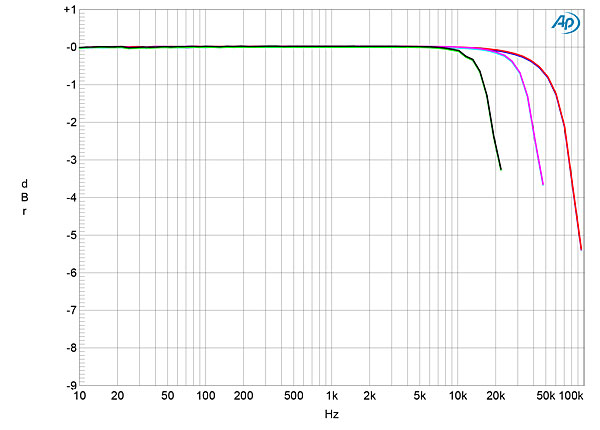

Fig.5 shows the C1.2's balanced output spectrum with a dithered 1kHz tone at –90dBFS with 16-bit data (green and gray traces) and with 24-bit data (blue and red traces). With the 16-bit data the noisefloor is that of the dither; with 24-bit data the noisefloor drops by around 20dB, which suggests a high resolution between 19 and 20 bits. However, a regular series of harmonics is present with the 24-bit data, with the odd-order harmonics the highest in level. (The unbalanced outputs behaved identically, other than with lower levels of the even-order harmonics.) This behavior implies that the lowest significant bit is being truncated. With undithered 16-bit data at exactly –90.31dBFS, the three DC voltage levels described by the data are well resolved (fig.6), and high-frequency noise is extremely low in level. With undithered 24-bit data at the same level, the result was a well-formed sinewave (fig.7).
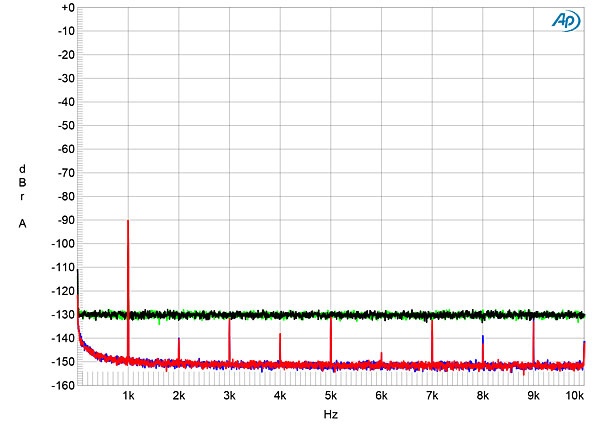


The red trace in fig.8 plots the error in the balanced output level as a 24-bit, 1kHz digital tone steps down from 0dBFS to –140dBFS. (This graph was taken with the left channel's output; the right channel behaved identically.) The amplitude error starts to increase below –80dBFS, which is associated with the harmonic distortion seen in fig.5. I understand that the C1.2 uses parallel pairs of PCM1704 DAC chips; the behavior in figs.5 and 8 might be due to the DAC pairs not being perfectly matched in low-level linearity. (Achieving good low-level linearity with R-2R ladder DACs is always difficult (footnote 1), which is why many designs use sigma-delta chips where this is not an issue.)
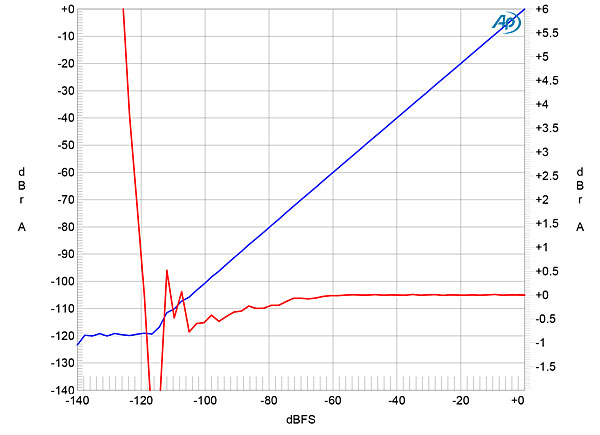
The C1.2 offered very low levels of harmonic distortion, with the third harmonic the highest in level at –100dB (0.001%, fig.9). Though other harmonics are present, these all lie at lower levels. These harmonics didn't increase in level when I reduced the load to 600 ohms, but the low-order harmonics decreased slightly in level when I reduced the signal level by 3dB. Fig.10 plots the spectrum of the C1.2's balanced output with an equal mix of 19kHz and 20kHz tones, the 24-bit signal peaking at 0dBFS. The use of a slow-rolloff reconstruction filter results in high-level aliased images of the tones at 24.1kHz and 25.1kHz, but actual intermodulation products are very low in level.
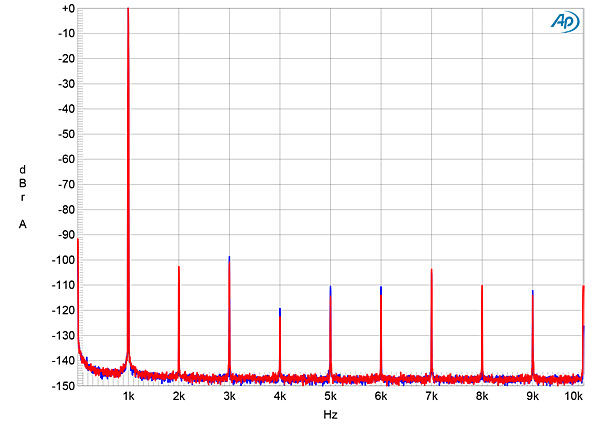
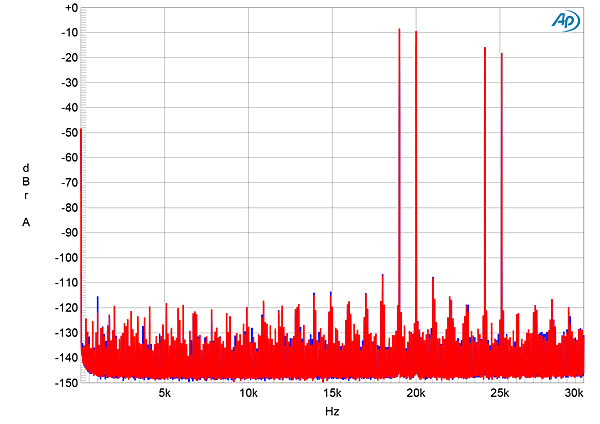
Finally, I tested the CH Precision's rejection of word-clock jitter with 16-bit, undithered J-Test AES3 and TosLink data. Other than those closest to the Fs/4 spectral spike, the odd-order harmonics of the LSB-level, low-frequency squarewave are very close to the correct levels (fig.11, sloping green line), and no other sidebands are present. With 24-bit J-Test data (fig.12), a single pair of sidebands was still present at ±229.6875Hz, but the random noisefloor lay at a very low –147dB.
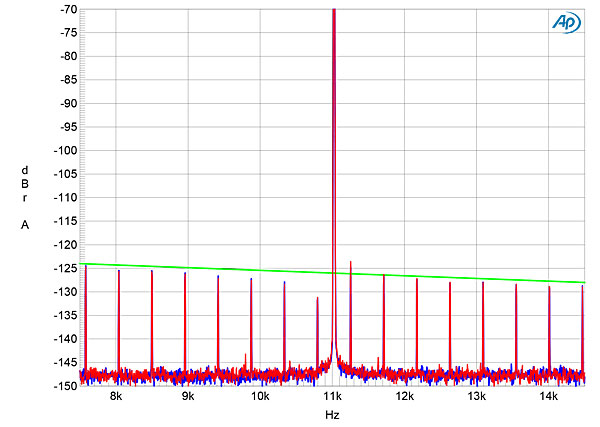

Other than the possible truncation of the 24th LSB and the mismatch of the DAC chips' low-level linearity, both of which were present with the earlier C1, the CH Precision C1.2 offers generally excellent measured performance. The C1.2's behavior is dominated by its use of a reconstruction filter optimized for time-domain performance, with its very slow ultrasonic rolloff.—John Atkinson

After the first page, the review image is, shall we say, rather blurred...

"Not just any DAC chip, but one that was an important step forward for digital audio when introduced—in 1998. It is Burr-Brown PCM1704 R-2R ladder DAC chip, four per channel. Why do it this way"
Have a listen to an old Naim CD555 to hear how good R2R ladder can sound.
The R2R PCM1704 was a killer converter chip. (just got too expensive to produce, having to laser trim all the minute R2R resistors Barrie Gilbert (AD) told me) Delta Sigma conversion good for DSD, ESS, Wolfson etc etc, doesn't have this laser resistor trimming problem, then they don't sound as good converting PCM 16 or 24 bit recordings either, they can only do a "facsimile" of it, where R2R ladders convert PCM "Bit Perfect"
If they were easy to get, even the discrete R2R dac manufacturers would use them. The "potential" (depending on the design) for far better specs are always there for a far smaller package of the same thing.
Cheers George

The question is, is an 80K+ Dac (with power supply and clock) also 8 times (800%) better than a 10K Dac (with everything integrated) or still only 0.2 (20%) better or still only 0.1 ( 10%) or even just 0.05 (5%). "The best sound I've heard" ... yes, I believe that ... but how much in proportion? That's not what the review says. Better but how much better? Let's say audibly better and yet really 0.2 (20%) (which seems a lot to me, but okay) for an 8 times (800%) more expensive. Is that proportional? The answer is of course subjective. And for many here, even a 10K is way beyond the available budget. Always nice to read about the Bugatti Chiron while driving an Audi A1, or looking for it and so to speak.

And if you listen with trained ears through topnotch audio systems well set up, it's frankly hard to miss the improvement in sound achieved by expensive DACs produced by companies committed to achieving the best possible digital sound.
Jim, hard to miss how? And why has no one anywhere ever been able to demonstrate this? Perhaps you can show us the way.

...but your remark prompts a tangential question anyway: Would you like to tell me what I hear?
See, the Editor already included the answer to your question. He heard the sound of it. I'm not sure how else it would manifest if not through hearing, that being the point.
From that I think it's fair to ask if you missed that or if you're alluding to denying another listener their impressions. Hence, would you like to tell anyone else what they hear too.
Would you then expect someone to somehow demonstrate these things to you? How? By what means? And who are you or I that it matters when you effectively admit you cannot or will not hear it anyway? What proxy is this you propose that not hearing a thing, you are interested in a demonstration of its presence anyway?
The biggest problem with the objectivist line is that taken to its conclusion it's a tacit admission that s/he's not capable of hearing a thing. At which point then why bother with better audio at all?

Not being able to admit one hears great musical presentation when listening through a $1M system at an audio show remains the last vestige of proof objectivists willingly deny.
Many have walked out of MQA demos without listening to 1 minute of music before reaching their summary judgment.
They are a literally 'not bothering with better audio' at all. They are the very definition of fool.
Some patience and willingness to hear the difference, in spite of their theoretical dogma, is the key.

...argue online about anything and given anonymity, do so with reckless abandon. Audio is no exception. With this in mind it's no leap to predict they'll make meaningless noise about things they've never heard, don't understand, couldn't technically comprehend, and deny others the effect of.
I hope writers and readers realize the pop-objectivity movement only purports to have scientific interest. They're malcontents. They're actually coming for your enjoyment.

Is that many are unwilling to set up an unsighted test, because they will find out that they don't have golden ears and can't hear many of the differences they claim to hear.
Doesn't mean no one can; just means many make the false assumption that they can. They don't want to face the reality that they can't.

... no subjectivist line. I hear. The problem is the incivility and intolerance you harbor because I do.
I also don't need an unsighted test. Again, I hear. In effect I "set up" an unsighted test every time I plug something in, almost always finding that what I thought it would do it won't. It goes and does what it actually is because it is. I allow for that and I enjoy that. There I learn; I learn because I'm a scientist and not what you'd like to think I am, your complete stranger.
That's the difference. That's the intellectual asymmetry. This drives you nuts and your recourse is to lash out. You're postmodern audio-woke. You despise that classical structure and you've invented a new pseudo-ethical system you wish you controlled.
So. You're projecting and further, you're doing it among your superiors, not the degenerates you seem to think number these subjectivists you think you're on about. For your dysfunction to work in your mind you have to invent adversaries that don't exist. So you do and here we are.
Your formulation is logically incomprehensible and I suspect you'll deny it forever.

Total nonsense.
One, where did I lash out? I think reading posts, it's obvious who's projecting and who's inventing adversaries. It isn't me.
And the fake intellectual approach is just you hiding ad hominem arguments behind sophisticated language instead of discussing.
All I wrote was most audiophiles don't actually test themselves and find out if they can really hear differences. There's no illogic there. It's a fact. How many audiophiles have ever actually taken a listening skills test like the Harman one to see how golden their ears are?
Most ignore the role expectation bias plays in human perception.
A good scientist would acknowledge all of that and deal with it instead of pretending it doesn't exist and exaggerating his abilities.

...that you have an opinion.
What I have is a demand: Where's the statistical proof that seeing a big walnut box alters the way it sounds versus a small black one. Or a shiny amplifier versus a utility enclosure. Or a fat cable versus lamp cord.
Isn't that your sighted bias canard in a nutshell? Then for it not to be a canard I expect tables of cited evidence of these sighted biases and not the usual driveby youtoob mcgurks.
Where's your statistical proof a commercial for-profit organization has captured the essence of all natural auditory phenomenona per all recreated sound from all conceivable reproduction systems and has interpreted it strictly for that benefit and across all use cases?
Where's the statistical proof the unnatural structure of your forced listening test is utterly transparent, not just technically but mentally, psychologically, and auditorily? Remembering your foregoing sighted bias, that is.
These are not rhetorical questions and I expect you to answer each of them with scientific rigueur and depth and references. You haven't. What you have done instead, not just throughout your work here but in this one comment alone, is
-Denied obvious reason;
-Expressed an assortment of frankly risible opinions based on generalities;
-Denied an obvious truth with unfounded, accusing opinion;
-Based on an assumption, issued a completely ambiguous demand;
-Denied it;
-Asserted an arbitrary standard (which I now demand you confirm per statistical proof that it speaks for all audio, all hearing, and all experience);
-Asserted another unmoored generality without evidence;
-Closed with doublespeak, rhetoric, and an uninformed lie, accusing your interlocutor himself of lying.
You're excellent at open opinion, DH, and frankly you're very good at the character defect so many of us have seen for so long among your kind. Now let's see your body of research supporting a more factual basis.

Try checking the Harman research on sighted listening bias.
Or the massive amounts of studies on all types of human perception, including audio perception that show expectation bias. It's really not hard to find.
Not long ago it was shown that humans even hear different volume levels (where none exist) and that the perceived volume level changes according to the color of the volume knob they are presented with. Just one of many examples.
It's massive and undeniable, except by people like you who refuse to see if their listening skills actually stand up to scrutiny.
My position (that not everyone has golden ears and that expectation bias in listening exists) is backed by science. Are SOME people skilled listeners and able to hear small differences? Yes. But a minority. And certainly not all those who ASSUME they are.
You are the one taking an extreme position - that both of those ideas mentioned above are false, and that you and other audiophiles all have golden ears and are immune the the basic workings of the human mind.
My position is backed by science. Yours is backed by ego and wishful thinking.
The onus is on you to prove your a-scientific assertation.

...Google it. Like one of the local writers said to a fellow traveler in another thread recently, that's a system of belief:
Do you have research to back up your assertion, David? ... Because, if not, it's simply your belief.
To which I'll add, now you admit it's a belief; that neither he or you or anyone else can begin to mind-read the subjects or even conceive of the technical granularity needed to validate the claim, the belief. You invoke science in a decidedly unscientific, even anti-scientific rhetorical ploy, and you further admit no acuity or appreciation for the ways and means of the people you troll, scientific or otherwise.
Again quoting Jason:
As I learned a long time ago from my cursory exposure to A Course in Miracles, there is nothing to defend. What there "is" to do is pay very particular attention to set-up, upgrade my system to make it a fine tool for discerning differences large and small, listen closely, and write with integrity and dedication to what I perceive to be the best interests of readers of Stereophile.
Bravo. As it should be. And those best interests are reciprocal, DH.
None of this was a mystery before and with each passing comment you drive that point home. "Google it. Because science and commercial interest." And any extrapolation of this basis in your purported body of objective fact shall not and may not apply, while any expectation it apply will be not just refused but baldly denied.
Like I just said, driveby mcgurk the thing anyway. Because science. But really because you really can't get to the granularity needed, can you, and you can't imagine what it might be. You're left with, as you just did again, projecting a coarse generality borne by a meager, unqualified belief about physical systems, systems you didn't engineer and systems you, evidently, cannot hear.
And that, DH, is actually the very core of anti-science. That is your impediment to discovery.

Great review. Actually, the best review of anything I've read regardless of the topic. Engaging, factual, informative, fun with the added spicy of honesties. The very best review I've ever read. Kudos, Jim Austin!

Hi Jim,
Your question, "What, then, is the point in paying tens of thousands of dollars for a D/A converter?" resonated with me. I had been very happy for several years with my BorderPatrol DAC (I know it caused some controversy in these pages). When shopping for a DAC, it clearly offered, to my ears, the best sound quality to cost tradeoff in my price range. Then last year I was at my local hi-fi shop where I heard a system similar to mine playing through a Chord Dave (about 10 times the price of the BoarderPatrol DAC). It ruined me. It was better in all ways that matter to me. So, I guess case in point. Thanks.
--Monty

"What, then, is the point in paying tens of thousands of dollars for a D/A converter?"
My first post, if designed right it "could" compete or even better the MSB R2R Ladder Discrete dac, similar pricing.
Not to mention trying to get the PCM1704k dac chips, as they are as rare as rocking horse **** to find, and big $$$$$ if you do.
Cheers George

Since when did frequency and time-domain performance exist as separate dimensions rather than intercorrelated in digital sampling?
Since when did we accept this as true?
"Time smearing is basically if you put a single pulse through the system, if you have a filter with a very long impulse response, that single sample will extend over a large number of samples."
That shorter impulse response has anything to do with improved sound quality because "time smearing" is supposedly better!?
Some of the best time-domain performance comes from designs like the Chord DACs. I agree with MontyM that a Chord DAVE is superior to his BorderPatrol (but no need to think this is about the price of the device!). Look at the impulse response of those Chord devices - and corresponding frequency response.
A long impulse response is not a measure of problematic audio "smearing". It's just a reflection of the device's filter when fed a poorly or non-low-passed signal like that single-sample "unit impulse".
Subjectivists like to believe that "measurements don't matter". So why believe the impulse response correlates to anything that subjective-leaning audiophiles should look at and think makes a difference?!
I'm sure the CH DAC sounds fine; although clearly the measurements show limitations like linearity of the old DAC PCM1704, and right-left variations as JA noted. Worth thinking about given the asking price.

...subjectivists that believe that "measurements don't matter". Rather they believe that measurements have not captured either the magnitude or ranked importance of all audible phenomena. This is because they hear; they do audio for the experience and find that data must serve that end.
There is copious evidence, including in regular drive-by remarks in these threads from the ASR swamp, that Objectivists like to believe that measurements are all that matter, notwithstanding that those measurements are meaningfully incomplete. This is because they do not listen; they do audio as a cancel culture and also find that data must serve that end.

"...would you still need to smoke a cigarette?" No. I would take two aspirins instead.
"And does this equate good comments with sex?" Let's just say that the best comments can give me a spontaneously rapturous release.

Reading thi review I have the sensation that the Stonehenge layout reveals the secrets of Betelgeuse.

Archimago: "I'm sure the CH DAC sounds fine; although clearly the measurements show limitations like linearity of the old DAC PCM1704, and right-left variations as JA noted."
That's just implementation, not the fault of the PCM1704-K dac chip itself, as shown here with JA doing the same measurement on the Mark Levison 30.6 which also uses 4 x PCM1704-K chips.
JA: "With its superb linearity and low noise floor, it comes as no surprise that the '30.6's reproduction of an undithered 1kHz tone at -90.31dBFS is essentially perfect."
Cheers George

The very expensive DACs may sound a little better.
I contend that the vast majority of audiophiles won't be able to tell 2 very good DACs apart in an unsighted test.
Most don't have golden ears - they just like to tell themselves they do, and never test themselves to find out if they actually do. They often rely on imagined differences brought about by expectation bias.

...set of projections, if by interesting we mean boring as hell. Would you like each fallacy of your contention exploded in order or as a lump sum?

Don't need your "help". And no fallacies involved. I've seen it happen multiple times. Audiophiles are sure they know which amp is which, until they listen unsighted. Then they can't tell and those obvious differences suddenly aren't.
Doesn't mean the reviewer or some people can't hear the difference between this DAC and a $1000 Chinese one. But it means lots of readers of this publication, some of whom are very sure they can, can't.

...probably don't want help evaporating that abject mythology. That's not a mystery; it never was, and I appreciate your saving us even more time.
I recommend continuity: Reduce all your exploits in great sound to more of the same artificiality that makes everything sound equally forced and distilled. Go AB some chifi. Use one recording, take 15 second snippets, keep score, and always involve agreeable minds. Music is to be a miserable, smug competition. Then make ambiguous references to these vague fields full of your imagined projections of the shortfalls of others that you'll personally never suffer from because you're you. You advance fine audio by leaps and bounds by the day.

Your smugness and arrogant prove nothing about your supposed point, but lots about you.

At 44.1kHz, we think we can hear filter artifacts. Maybe. On certain program.
At 96kHz original program, the artifacts are gone. We hear no filtering issues, regardless of program.
Technique doesn't matter. "Splines" don't matter. All of this seems 100% related to magnitude response over time.
The $1M question becomes: On a 44.1 signal, is it less harmful to do a high quality up-SRC before filtering? Or avoid SRC and filter at native 44.1?
In our experience, and apparently in the experience of CH, Weiss, and others, using a pristine SRC to 192 or 384 (etc) is the better approach. SRC to 96 is probably just fine, as well.
Is any of this deeply unique engineering? Naw. Simple stuff, really.